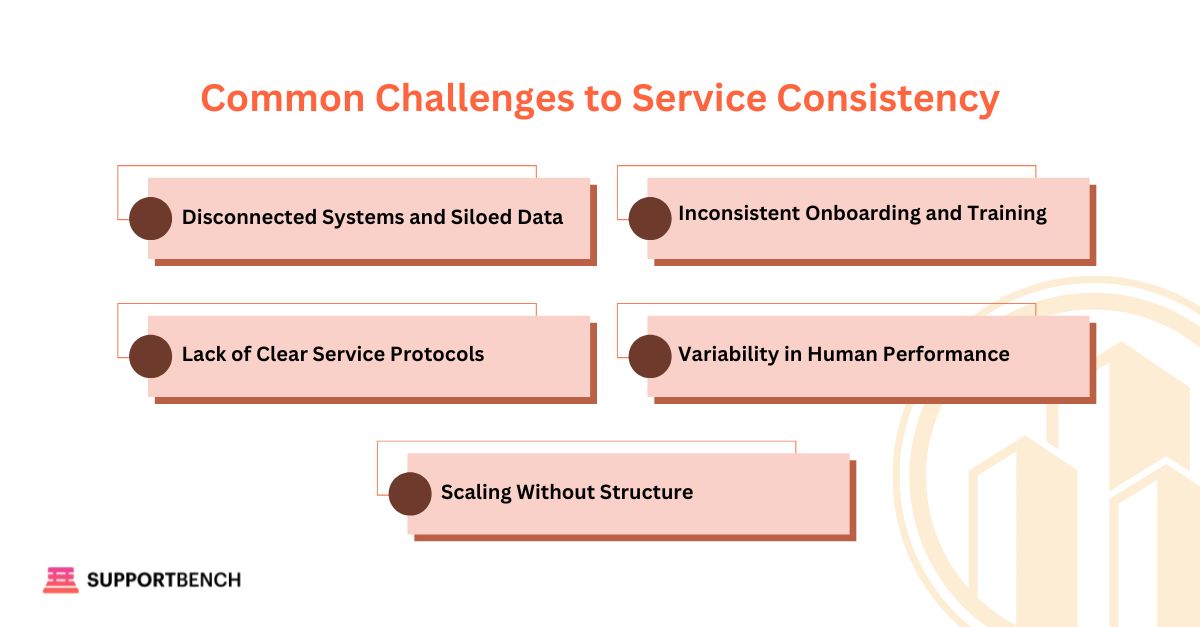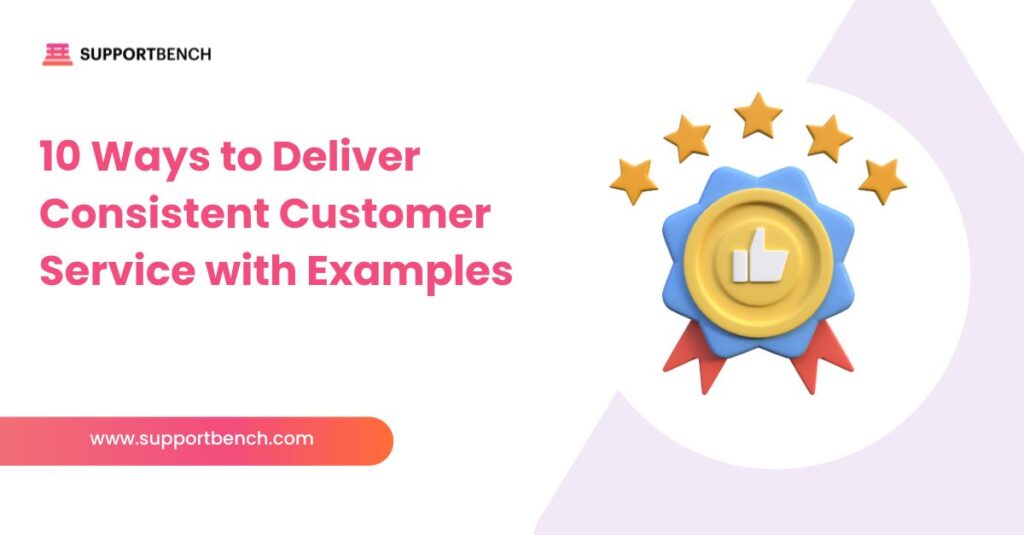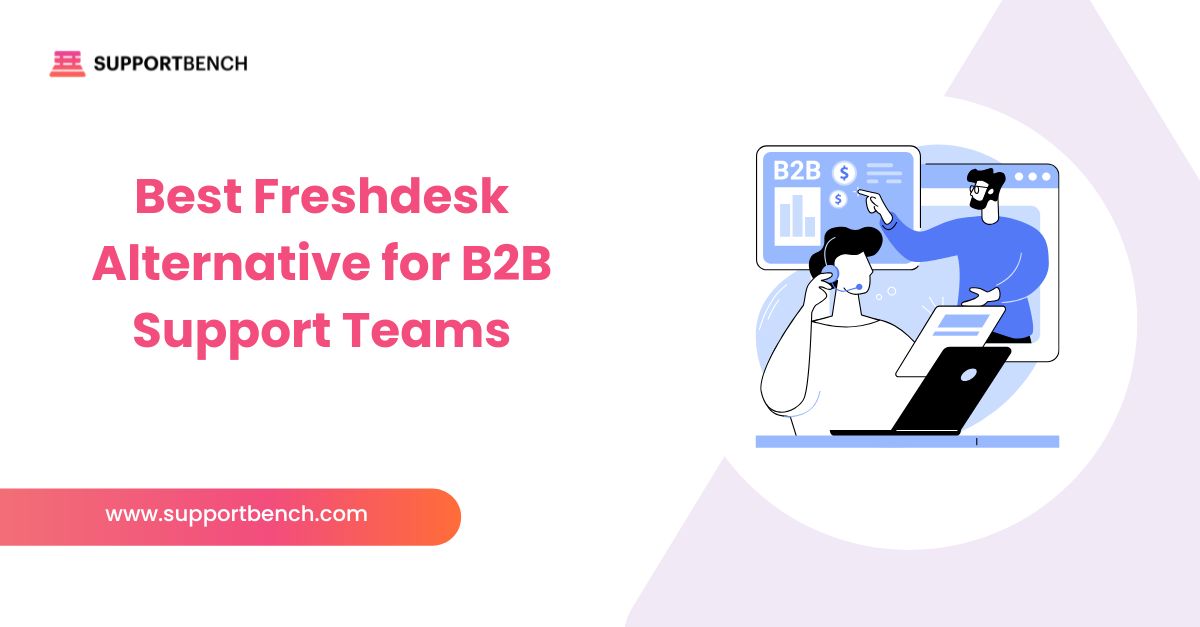In today’s competitive B2B landscape, providing consistent customer service is more than a goal—it’s a necessity. Every interaction shapes the way clients perceive your brand, and even small lapses in service can erode trust.
This guide is designed for support professionals, team leaders, and CX strategists looking to strengthen service delivery across every channel. Instead of repeating common advice, we’ll focus on real strategies that work in B2B settings.
You’ll find practical methods, case examples, and tools that help support teams deliver steady, predictable experiences. Whether you’re starting fresh or refining your current systems, this article will help you build consistency into every customer touchpoint.
At a Glance:
Consistent customer service builds trust and drives loyalty—especially in B2B. This guide offers 10 proven strategies, from setting clear expectations and standardizing workflows to training teams, using CRM tools, and acting on feedback. Real-world examples from Zappos and Costco show how structured systems and empowered teams create reliable support experiences across every touchpoint.
What Is Consistent Customer Service and Why It Matters
Consistent customer service means delivering the same high-quality support across every channel, agent, and interaction. Whether a client reaches out by email, phone, or live chat, they should receive a dependable response that reflects your brand’s values—regardless of who they speak to or when.
In a B2B environment, where relationships are built over time and often involve complex products and multi-stakeholder accounts, consistency is more than a nice-to-have. It reassures clients that your team understands their history, is aligned on priorities, and can be counted on to deliver a professional experience every time.
Consistency fosters trust. It signals operational maturity, reduces friction, and helps your team deliver predictable, repeatable service—even as your organization grows.

The Cost of Inconsistency
When support quality varies across channels or team members, it quickly erodes credibility. One agent might give a clear, accurate response—while another offers a vague or even contradictory answer. This creates unnecessary back-and-forth, frustrates customers, and increases escalations.
Over time, these inconsistencies affect core metrics like Customer Satisfaction (CSAT), Net Promoter Score (NPS), and first-response time. In high-value B2B relationships, poor performance in any of these areas can lead to contract loss, reduced renewals, and reputational damage.
Driving Consistency Through Systems and Culture
Creating consistent service isn’t about scripts—it’s about structure. High-performing teams use repeatable systems and shared tools to ensure no matter who answers the request, the quality feels the same.
Three key drivers make this possible:
- Standard Operating Procedures (SOPs): SOPs align agents around a shared response process, defining steps, tone, and escalation paths.
- Customer Service Training Programs: Ongoing training ensures new and existing team members operate with the same expectations and skill set.
- Implementing CRM Systems: A centralized CRM helps unify customer data, so agents can access histories, preferences, and prior interactions instantly.
Together, these systems reduce variability, speed up onboarding, and embed consistency deep into your support culture.
1. Set Clear Expectations
A consistent customer experience starts with clear expectations—both for your customers and your support team. When everyone understands what “good service” looks like, it becomes far easier to deliver it consistently.
Why Setting Expectations Matters
Clarity eliminates guesswork. When customers know your response times, escalation process, or what qualifies for premium support, they’re less likely to feel ignored or confused. And when support agents understand their responsibilities, it helps standardize how they interact with clients—even in high-pressure moments.
Take something as simple as response time. If you define a clear target—say, replying to tickets within two business hours—every agent can align with it. Customers benefit from predictability, and your team has a benchmark to meet.
Well-defined expectations also reduce service variation. With consistent internal guidelines, customers will receive the same level of care, whether they’re talking to a new hire or your most experienced team lead.
What This Looks Like in Practice
Let’s say your support team handles onboarding for enterprise clients. Without shared guidelines, each rep might take a different approach—leading to uneven experiences.
Instead, create a clear onboarding outline. Define the communication cadence, available resources, and typical timeline. Share this with clients at the start of the engagement.
By doing so, you set expectations early and build alignment before a ticket is even opened.
When expectations are standardized and clearly communicated, everyone benefits: customers feel respected and informed, while your team operates with greater confidence and consistency.
2. Prioritize Customer Service Skills Training
Support agents can’t deliver consistent service if their skills are uneven. That’s why structured, ongoing training is one of the most effective ways to embed reliability into your support operations.
Why Ongoing Training Matters
Customer expectations evolve. Tools change. Products update. Without regular refreshers, even experienced agents may fall out of sync with your service standards.
Training keeps your team aligned. It helps ensure that everyone—whether newly onboarded or long-tenured—understands how to communicate clearly, follow best practices, and uphold your brand standards.
It also improves team morale. When agents feel confident and capable, they’re less likely to burn out or leave. This stability leads to fewer handoffs, stronger client relationships, and a more consistent customer experience.
What Skills to Prioritize
Focus on essential interpersonal and technical skills that directly impact customer outcomes:
- Active listening – Helps agents fully understand issues before responding.
- Empathy – Builds trust by showing customers they’re heard and respected.
- Problem-solving – Enables reps to resolve issues without unnecessary delays or escalations.
- Adaptability – Prepares agents to handle varied personalities and unexpected challenges.
- Clear communication – Prevents misunderstandings, especially with technical topics.
- Product and system knowledge – Ensures fast, accurate, and consistent responses.
A Practical Example
Tie training efforts to measurable goals. For example, if CSAT scores are slipping, develop a focused session on tone and clarity during escalations. This links learning directly to performance—and drives real improvement.
When training is consistent and purposeful, customer service becomes that way too.
3. Implement Customer Feedback Loops
Consistency in service isn’t something you set once and forget. It requires regular input from the people you’re serving. That’s why gathering customer feedback is essential—it helps identify what’s working, where gaps exist, and how to keep improving.
Why Feedback Matters
Customer feedback reveals more than isolated complaints. It shows patterns—like recurring issues, unclear processes, or standout team members. Used effectively, this insight helps you refine training, update documentation, and adjust expectations to better serve your audience.
It also sends a strong message to your clients: their opinions matter. When customers see that their input leads to change, it strengthens loyalty and trust.
Practical Feedback Methods
There’s no one-size-fits-all way to collect feedback. Mix methods to capture different types of insight:
- Surveys – Use post-interaction surveys to track satisfaction and spot friction points.
- Net Promoter Score (NPS) – Measures willingness to recommend your service and flags churn risk.
- Social media monitoring – Keep tabs on unsolicited feedback shared on public platforms.
- Direct comments – Encourage open responses via email, live chat, or phone follow-ups.
Closing the Loop
Feedback doesn’t drive change unless it’s acted on. Review results regularly, share insights with your team, and tie decisions—like new SOPs or training updates—back to what customers are saying. When you build that loop, consistency becomes a moving target you’re always improving toward.
4. Utilize Technology and Tools for Efficiency
The right tools make consistent service easier to deliver—and scale. Technology doesn’t replace human support, but it ensures your team works from the same playbook, with shared visibility and fewer manual gaps.
How Tools Support Consistency
Support platforms help standardize processes and eliminate variation. They can guide agents through workflows, prioritize tickets, and provide access to the same customer context—regardless of who’s responding.
They also reduce human error. Automated routing, templated responses, and searchable knowledge bases ensure the same standard of care gets applied across the board.
Key Tools to Consider
✅ Helpdesk software – Centralizes tickets, tracks performance, and improves response coordination.
✅ Knowledge bases – Offer fast access to troubleshooting steps, policy info, and escalation paths.
✅ Live chat and chatbots – Ensure round-the-clock responses and reduce wait times for common issues.
✅ Reporting dashboards – Provide real-time visibility into performance trends and service consistency.
✅ CRM platforms – A connected CRM lets agents see past conversations, account history, and preferences—helping them deliver informed, reliable support at every touchpoint.
Keep It Aligned
Choose tools that integrate with your existing systems. And make sure your team knows how to use them well. Technology only supports consistency when it’s applied thoughtfully and used consistently across the board.
5. Implement a Knowledge Base and KCS Methodologies
A reliable knowledge base is a foundational tool for delivering consistent customer service. It gives support teams a single source of truth—and helps customers find answers on their own.
Why a Knowledge Base Matters
When agents have quick access to up-to-date information, they don’t need to guess or improvise. They follow the same procedures, use the same terminology, and provide consistent answers—even in high-pressure situations.
Customers benefit too. A well-maintained knowledge base empowers them to solve issues independently, reducing ticket volume and improving satisfaction.
Benefits of a Knowledge Base
✅ Faster resolution – Agents spend less time searching for answers and more time solving problems.
✅ Consistent responses – Everyone relies on the same information, ensuring accuracy.
✅ Self-service options – Customers can resolve simple issues on their own, without waiting.
✅ Continuous improvement – Content evolves based on feedback and recurring support patterns.
Layer in KCS for Better Results
Knowledge-Centered Service (KCS) is a framework for creating and maintaining your knowledge base in real time. It treats documentation as part of the support process—not a separate task.
Here’s how KCS works in practice:
- Agents create or update articles while solving real cases.
- Popular content gets reviewed and improved regularly.
- Knowledge is shared across the team and refined based on usage data.
- Performance of the knowledge base is measured just like any other support tool.
This approach keeps your documentation relevant, scalable, and deeply integrated into how your team works. It turns knowledge into a live resource—not a static archive.
6. Establish Personalized Customer Service
Consistency doesn’t mean delivering the same generic experience to everyone. It means offering the same level of care—tailored to each customer’s unique context. That’s why personalization is a critical part of consistent service.
Why Personalization Supports Consistency
When customers feel recognized and understood, their experience improves. They’re more likely to trust your team, stay loyal, and forgive small hiccups along the way.
Personalization also helps prevent robotic or transactional interactions. It makes your service feel intentional—even when delivered at scale.
Strategies for Personalizing Service
✅ Use available data – Reference previous tickets, preferences, and company details to inform your responses.
✅ Segment support teams – Group agents by product expertise, industry, or account type to align with customer needs.
✅ Tailor communication – Address customers by name, reference past conversations, and avoid canned responses.
✅ Train on soft skills – Invest in listening, empathy, and tone adjustment so agents can build real rapport.
✅ Be proactive – Reach out before problems escalate, especially for high-value accounts or recurring issues.
A Real-World Example
Say a returning client reaches out about a billing question. If the agent references the client’s past tickets and uses their preferred contact method, the customer doesn’t have to start from scratch. That small touch reinforces trust—and reflects the kind of consistency that builds long-term loyalty.

7. Develop a Strong Company Culture
Consistent service starts with consistent values. A strong internal culture shapes how your team communicates, solves problems, and represents your brand.
When everyone shares the same priorities—especially around customer experience—it becomes easier to deliver reliable support, no matter the situation.
How Culture Drives Consistency
✅ Shared values – When support teams understand what your company stands for, they’re more likely to act in ways that reflect those values.
✅ Employee engagement – Motivated, supported employees show up more consistently in tone, effort, and care.
✅ Stronger collaboration – A culture of trust encourages knowledge sharing and teamwork, which improves outcomes for customers.
How to Build It
✅ Define what matters – Make your customer-focused values explicit. Post them. Reinforce them.
✅ Recognize great service – Highlight agents who go above and beyond. This shows that consistency and care are not just expected—they’re appreciated.
✅ Provide growth paths – Offer opportunities for training, leadership, or specialization. Growth-minded teams tend to be more invested.
✅ Model from the top – Leadership should embody the same values they expect from the support team.
When your internal culture supports service excellence, consistency becomes second nature—not a checklist item.
8. Monitor and Analyze Key Performance Metrics
You can’t improve what you don’t measure—and you can’t ensure consistency without tracking it. That’s where customer service KPIs come in. They help you spot patterns, identify gaps, and maintain a high standard of performance over time.
Why Metrics Matter
Metrics reveal whether your service delivery matches your expectations—and your customers’. They show where things are working, where they aren’t, and how consistent your results really are.
They also help you align your team. When agents know which KPIs matter and how they’re measured, it gives them a clear target to work toward.
Key Metrics to Track
✅ First response time – Speed of your initial reply, a key part of perceived reliability.
✅ Resolution time – How long it takes to fully resolve an issue.
✅ Customer Satisfaction (CSAT) – Captures the customer’s immediate experience after an interaction.
✅ Net Promoter Score (NPS) – Gauges long-term satisfaction and loyalty.
✅ Ticket backlog – Helps monitor team capacity and response delays.
✅ Agent utilization – Tracks workload distribution and efficiency.
How This Drives Consistency
Real-time dashboards help you catch drops in service before they snowball. Monthly trend reports show whether your team is improving. And when paired with coaching and SOP updates, these insights create a feedback loop that strengthens consistency over time.
9. Embrace a Customer-Centric Approach
A consistent service experience depends on putting the customer at the centre of every decision. When your team is guided by what customers need—rather than what’s convenient—consistency becomes a natural outcome.
What It Means to Be Customer-Centric
Being customer-centric isn’t just about solving problems. It’s about anticipating them. It’s about knowing your client’s business, not just their last support ticket. And it’s about delivering value at every stage—not just at onboarding or renewal.
When your team adopts this mindset, every interaction is handled with care, thoughtfulness, and accountability.
How to Embed This Mindset
✅ Actively listen – Let customers explain their challenges without rushing to respond.
✅ Empower your agents – Give them the freedom to make decisions that serve the customer—not just the script.
✅ Map the customer journey – Understand where inconsistencies tend to happen so you can fix them.
✅ Train for empathy – Make space for emotional intelligence, not just technical skill.
✅ Align teams across functions – Make sure support, sales, and product are unified around customer success.
When customer-centricity is part of your culture—not just a line in your mission statement—your service becomes more consistent, more reliable, and more trusted.

10. Continuously Improve and Adapt
Consistency doesn’t mean staying the same—it means staying aligned while evolving. To keep service quality high, your team needs a habit of reviewing what’s working, identifying gaps, and making smart adjustments over time.
Why Improvement Must Be Ongoing
Customer needs shift. Products change. What worked last quarter might not work tomorrow. Teams that don’t adapt fall behind—and so does the quality of their support.
Improvement also reinforces trust. When clients see your team getting faster, clearer, and more helpful over time, it shows commitment—not just competence.
How to Build a Culture of Adaptation
✅ Evaluate regularly – Review key metrics and customer feedback every month or quarter.
✅ Encourage agent input – Your frontline team sees the cracks before anyone else. Listen to their ideas.
✅ Spot trends early – Look for repeating issues, not just individual complaints.
✅ Test and refine – Pilot changes with small groups before rolling them out widely.
✅ Stay curious – Keep an eye on industry trends and new tools that could improve your workflows.
Improvement isn’t a separate project—it’s a rhythm. When your team embraces it, consistency becomes more than just a standard. It becomes a strength.
Turning Process Into Performance: Implementing SOPs for Service Consistency
As your team grows or support needs become more complex, keeping service consistent becomes harder. That’s where Standard Operating Procedures (SOPs) come in.
SOPs give your team structure. They outline how to handle common issues, guide tone and resolution steps, and create predictable experiences for customers—regardless of which agent is responding.
Why SOPs Matter
Inconsistent service usually stems from one of three things: unclear responsibilities, agents improvising responses, or differences in how issues are escalated. SOPs address all of these by offering a shared playbook.
They also help new hires ramp up faster and reduce the training burden on senior staff. Most importantly, they support a reliable experience for the customer—every time.
You Might Also Like:
What Makes an SOP Effective
A useful SOP does more than list steps. It gives structure, clarity, and room to evolve. Strong SOPs include:
- Clear objectives – Define what each SOP is meant to solve (e.g., onboarding, escalation, or billing errors).
- Step-by-step guidance – Break tasks down into specific, actionable steps.
- Assigned ownership – Clarify who is responsible for what—so nothing falls through the cracks.
- Standard tone and language – Ensure consistency across written and verbal communications.
- Edge-case handling – Include what to do when something doesn’t follow the normal path.
- Scheduled reviews – Define how often SOPs will be updated, and by whom.
How to Roll Them Out
✅ Start with high-impact scenarios – Document common or complex situations like password resets, onboarding calls, or product bugs.
✅ Co-create with agents – Get feedback from your team. They know where things get stuck.
✅ Test before scaling – Run SOPs in small groups, refine them, and only then apply them company-wide.
✅ Embed them into your tools – Link SOPs inside your CRM, helpdesk, or internal wiki so they’re easy to access when needed.
Treat SOPs as a Living Asset
Service expectations shift—and your SOPs should, too. Update them regularly based on feedback, KPI data, and product changes. When SOPs evolve alongside your business, they don’t just support consistency—they drive it.
Solving the Hidden Challenges of Consistent Customer Service
Even with SOPs, great tools, and a trained team, consistency can still break down—especially as your organization scales. The reasons often aren’t obvious. But if you know what to look for, you can solve them before they affect your customer experience.

1. Disconnected Systems and Siloed Data
When teams use different tools that don’t sync, agents can’t see the full customer history. That leads to repeated questions, missed context, and conflicting responses.
Solution: Use a unified CRM and support platform that pulls all customer interactions, notes, and account data into one place. This ensures continuity, even across teams or time zones.
2. Lack of Clear Service Protocols
When team members don’t follow standardised processes or interpret them differently, it If agents follow different processes—or interpret SOPs their own way—consistency falls apart.
Solution: Build clear, detailed SOPs for high-impact scenarios. Include tone, steps, and escalation paths. Make them easy to access, and review them often.
3. Inconsistent Onboarding and Training
Without a structured onboarding process, agents develop their own habits. Over time, this creates wildly different support styles within the same team.
Solution: Use shadowing, mentoring, and scheduled refreshers to reinforce shared standards. Make sure every agent learns the same foundation—and keeps growing from there.
4. Variability in Human Performance
Even your best agents have off days. Stress, fatigue, and burnout all affect how consistently they show up for customers.
Solution: Build a supportive culture. Recognize good work, encourage time off, and give agents autonomy where possible. A healthy team is more consistent—and more resilient.
5. Scaling Without Structure
As your company grows, what worked for five agents won’t work for fifty. Without new systems in place, inconsistency becomes the norm.
Solution: Formalize your CX strategy. Track metrics like first-contact resolution and SLA adherence to spot breakdowns. Use these insights to coach your team and refine your processes.
Real-World Example of Consistent Customer Service in Action
Strategies and frameworks matter—but seeing them in action shows what true consistency looks like. Here are two companies known for delivering dependable, high-quality customer service at scale.
Zappos – Empowering Agents to Own the Experience
Zappos, an Amazon subsidiary, is famous for its customer-first culture. A key part of its consistency is agent empowerment. Instead of enforcing strict scripts, Zappos trains its agents on company values and gives them freedom to resolve issues however they see fit.
There’s no maximum call time. Agents are encouraged to stay on the line as long as it takes to help the customer feel heard and supported.
How SOPs Work Behind the Scenes: Even though agents don’t follow rigid instructions, they’re guided by shared service principles. This alignment—values over scripts—creates predictability without sacrificing personality.
Result: Zappos achieves high levels of customer satisfaction and loyalty. Many of its support stories go viral because of the empathy and initiative shown by its team.
Costco: Simple Policies, Predictable Experiences
Costco takes a different approach, focusing on consistent processes. Its famously generous return policy is enforced uniformly across all stores—no debate, no delay.
Whether you shop in Calgary or Los Angeles, the experience is the same: no receipt hassle, no unnecessary questions, just a smooth and fair resolution.
Why It Works: Costco’s policies are clear, publicly communicated, and strictly upheld. This creates a baseline of trust and fairness that keeps members coming back.
Result: Costco enjoys over 90% renewal rates in North America—driven not just by pricing, but by dependable, frictionless service.
These examples show that consistency doesn’t require one approach. Whether it’s flexible empowerment or policy-driven structure, the key is clarity, alignment, and a culture that prioritizes customer experience at every level.

Achieving Consistent Customer Service Excellence
Consistency in customer service isn’t about perfection—it’s about predictability. When your support team responds with the same level of care, clarity, and professionalism across every channel, you earn customer trust over time.
The ten strategies in this guide aren’t just best practices—they’re building blocks for long-term success. Together, they form a framework your team can rely on, even as your company grows or customer demands shift.
To recap, consistent customer service depends on:
- Setting clear expectations with both customers and internal teams
- Providing regular training to keep skills aligned
- Gathering customer feedback and using it to refine support delivery
- Choosing the right tools to support efficiency and collaboration
- Maintaining a knowledge base with KCS principles to guide agents
- Personalizing service without losing structure
- Building a culture that values accountability and growth
- Monitoring KPIs to track trends and make informed changes
- Putting customers at the centre of every decision
- Adapting processes based on new insights and changing needs
Companies that prioritize customer experience tend to see stronger loyalty and reduced churn. It’s not about having the largest team or the flashiest tools—it’s about building trust, one repeatable action at a time.
Encourage your support leaders to apply these strategies, test them, and share wins across the team. Every improvement strengthens the foundation for dependable, high-quality service.















